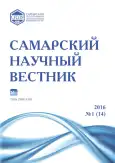Administrative and management systems in territories of tatars living at the end of XVIII - the beginning of the XX centuries
- Authors: Lyubichankovskiy S.V.1
-
Affiliations:
- Orenburg State Pedagogical University
- Issue: Vol 5, No 1 (2016)
- Pages: 97-102
- Section: 07.00.00 – Historical Sciences and Archaeology
- URL: https://journals.rcsi.science/2309-4370/article/view/21989
- DOI: https://doi.org/10.17816/snv20161205
- ID: 21989
Cite item
Full Text
Abstract
This article deals with the administrative and management systems which were used in the territory where Tatars lived (Ural-Volga region) in the Russian Empire. It is established that the living of the Tatar people wasn't considered as the main feature of the region. Thus, until 1917 there was no plan to set up a separate administrative unit covering the area of the prevailing Tatar population (unlike, for example, the Bashkir and Kazakhs). The then administrative system reflected the imperial character of the Russian state. It manifested itself in the formation of a vertical power structure supported by the local elite and taking into account local management traditions, but controlling all key institutes and positions. The hypothesis is proved that evolution of the Russian government in the territory of the Ural-Volga region was based on the process of gradually pulling up suburban territories to the standards of local management in central Russia. These standards didn't consider national traditions of management, were based on the unified principles of rationalization and bureaucratization of management with the priority of state interests in administrative practice.
Full Text
##article.viewOnOriginalSite##About the authors
Sergey Valentinovich Lyubichankovskiy
Orenburg State Pedagogical University
Author for correspondence.
Email: svlubich@yandex.ru
doctor of historal sciences, head of the Chair of History of Russia
Russian Federation, OrenburgReferences
- Бикташева А.Н. Антропология власти. Казанские губернаторы первой половины XIX века: монография. М.: Новый хронограф, 2012. 495 с.
- Любичанковский С.В. Империя Романовых и проблема управления культурно-гетерогенным пространством // Уральский исторический вестник. 2013. № 3. С. 59-68.
- Загидуллин И.К. О религиозно-культурной автономии татар в округе оренбургского магометанского духовного собрания // Ислам в современном мире: внутригосударственный и международно-политический аспекты. 2015. Т.11. № 3. С. 61-70.
- Любичанковский С.В. Кризис губернского управления регионами в позднеимперской России // Фе-дерализм. 2007. № 1. С. 127-140.
- ПСЗ-1. Т.XX. № 14392.
- ПСЗ-1. Т.XXI. № 15774.
- РГАДА. Ф.16. Оп.1. Д.636.
- Лысенко Л.М. Губернаторы и генерал-губернаторы Российской империи (XVIII - начало XX века). М.: Изд-во МПГУ, 2001. 353 с.
- ПСЗ-1. Т.XXI. № 15141
- ПСЗ-1. Т.XXII. № 16710
- ПСЗ-1. Т.XXIV. № 17634
- РГИА. Ф.383. Оп.9. Д.7674. Л.73.
- ПСЗ-2. Т.XII. № 10303
- Загидуллин И.К. Урало-Поволжский регион как «внутренняя периферия» империи (управленческий контекст) // Местное управление в пореформенной России: механизмы власти и их эффективность. Сводные материалы заочной дискуссии. Екатеринбург-Ижевск: УИИЯЛ УрО РАН, 2010. С. 450-452.
- Любичанковский С.В. «Внутренняя периферия» Российской империи: средне-волжский вариант // Вестник Ленинградского государственного университета им. А.С. Пушкина. 2013. Т.4. № 2. С. 165-169.
- ПСЗ-2. Т.ХL. № 42058
- ПСЗ-2. Т.XIX. № 17998
- СЗРИ. Т.2. Общее Учреждение Губернское (изд. 1892 г.). Ст.437-438, 467-471.
- РГИА. Ф.1284. Оп.185. 1910. Д.29. Л.93об.
- ГАОО. Ф.10. Оп.1. Д.175. Л.1-2.
- Усиление губернаторской власти. Проект фон Плеве. С предисловием П.Струве и с приложением дела орловского губернатора Неклюдова. Париж: «Освобождение», 1904. 112 с.
- Крафт И.И. Сборник узаконений о киргизах степных областей. Оренбург: Губернская типография, 1898. 314 с.
- Зиманов С.З. Политический строй Казахстана конца XVIII и первой половины XIX века. Алма-Ата: Политиздат, 1958. 428 с.
- ПСЗ-1. Т.XXXVIII. № 29126.
- ПСЗ-3. Т.II. № 886.
- ПСЗ-3. Т.XVIII. № 14908.
- ПСЗ-1. Т.XXV. № 18477.
- Годовова Е.В. Оренбургское казачье войско в XIX веке // Современная наука: актуальные проблемы теории и практики. Серия Гуманитарные науки. 2013. № 3-4. С. 16-21.
- ПСЗ-2. Т.ХL. № 42058
Supplementary files






